Michigan grape scouting report – July 2, 2025
Check out the latest Michigan Grape Scouting Report for timely updates on weather, vine growth, disease management, and pest activity. Stay informed and make proactive decisions to support vineyard health and productivity.

Weather update
Detailed seven-day forecasts for Michigan grape production regions are available below:
- Southwest Michigan: Benton Harbor, Fennville, Lawton
- Southeast Michigan: Romeo
- Northwest Michigan: Old Mission, Petoskey, Traverse City
Agricultural Weather Outlook: Weekly in-season weather updates are provided to the Michigan State University Extension fruit team by Jeff Andresen, Michigan State University (MSU) agricultural meteorologist. These reports offer timely insights into weather conditions affecting fruit production across Michigan.
Growing degree day (GDD) report
Track vine development using the MSU Enviroweather Growing Degree Day (GDD) map. Visit the site to find your nearest weather station, create a free account, and monitor GDDs daily: MSU Enviroweather GDD Tool.
Weekly GDD summary (base 50 degrees Fahrenheit)
The table below summarizes current GDD accumulation, last week's totals and the weekly increase for each monitored location across Michigan:
|
Location |
Current GDD (Base 50 F) |
GDD Last Week |
Weekly Accumulation |
|---|---|---|---|
|
Benton Harbor (SWMREC) |
1173 |
988.0 |
185.0 |
|
Fennville |
1058.1 |
883.2 |
174.9 |
|
Lawton |
1165.2 |
948.7 |
216.5 |
|
Average – Southwest Michigan |
1132.1 |
940.0 |
192.1 |
|
Romeo |
1020.4 |
849.8 |
170.6 |
|
Average – Southeast Michigan |
1020.4 |
849.8 |
170.6 |
|
Old Mission |
730.8 |
600.0 |
130.8 |
|
Petoskey |
716.7 |
594.8 |
121.9 |
|
Traverse City (NWMHRS) |
797.8 |
658.6 |
139.2 |
|
Average – Northwest Michigan |
748.4 |
617.8 |
130.6 |
Weather forecast
Following last week’s extreme heat, Michigan’s grape-growing regions are expected to experience a return to more moderate and seasonally appropriate conditions. In the northwest, growers can expect daytime highs in the mid-70s to low 80s, with cooler nighttime lows in the upper 50s to low 60s—ideal for reducing vine stress and supporting healthy canopy development. Southwest Michigan will remain warm, with highs in the mid-80s and lows in the mid-60s, while the southeast will start the week in the upper 80s before cooling to the low 80s by the weekend.
Scattered rainfall is forecast across the state, with more organized systems likely in the northwest. Rain totals are expected to range from 0.75 to 1.25 inches, with localized higher amounts possible in areas affected by thunderstorms.
These conditions will help replenish soil moisture but may also increase disease pressure, particularly in dense canopies. Monitor for signs of downy mildew and other fungal diseases, especially in humid areas. Pest activity may also increase as temperatures stabilize—keep an eye out for grape berry moth, leafhoppers and Japanese beetles.
Overall, this week offers a more favorable environment for vine development, but continued scouting and timely management will be essential.
Vine growth
In southwest Michigan, many varieties are at pea size with some approaching berry touch. Grape berry moth counts at the Trevor Nichols Research Center went down significantly from last week. There is severe powdery mildew risk for the rest of the week from July 2-9.
In northern Michigan, a recent bout of warm, humid weather has sparked a surge in growth among Vitis vinifera cultivars. Over the last week, shoot elongation has accelerated dramatically—shoots are now approaching the top wire, and most vine varieties are in bloom. According to the modified E-L system, the vines are at Stage 21 (approximately 30% capfall)
This rapid phase of both vegetative and reproductive growth makes it a critical time to focus on nutrient management. Earlier in the season, cooler soil conditions may have slowed nutrient uptake, but the recent warming has reactivated root function and improved nutrient absorption, supporting robust vine development.
Accurate phenological tracking is essential during this window—timely pest management, fertilization, and canopy adjustments can significantly affect yield and grape quality. For a precise staging guide, consult MSU Extension’s Grape Growth Stages chart.
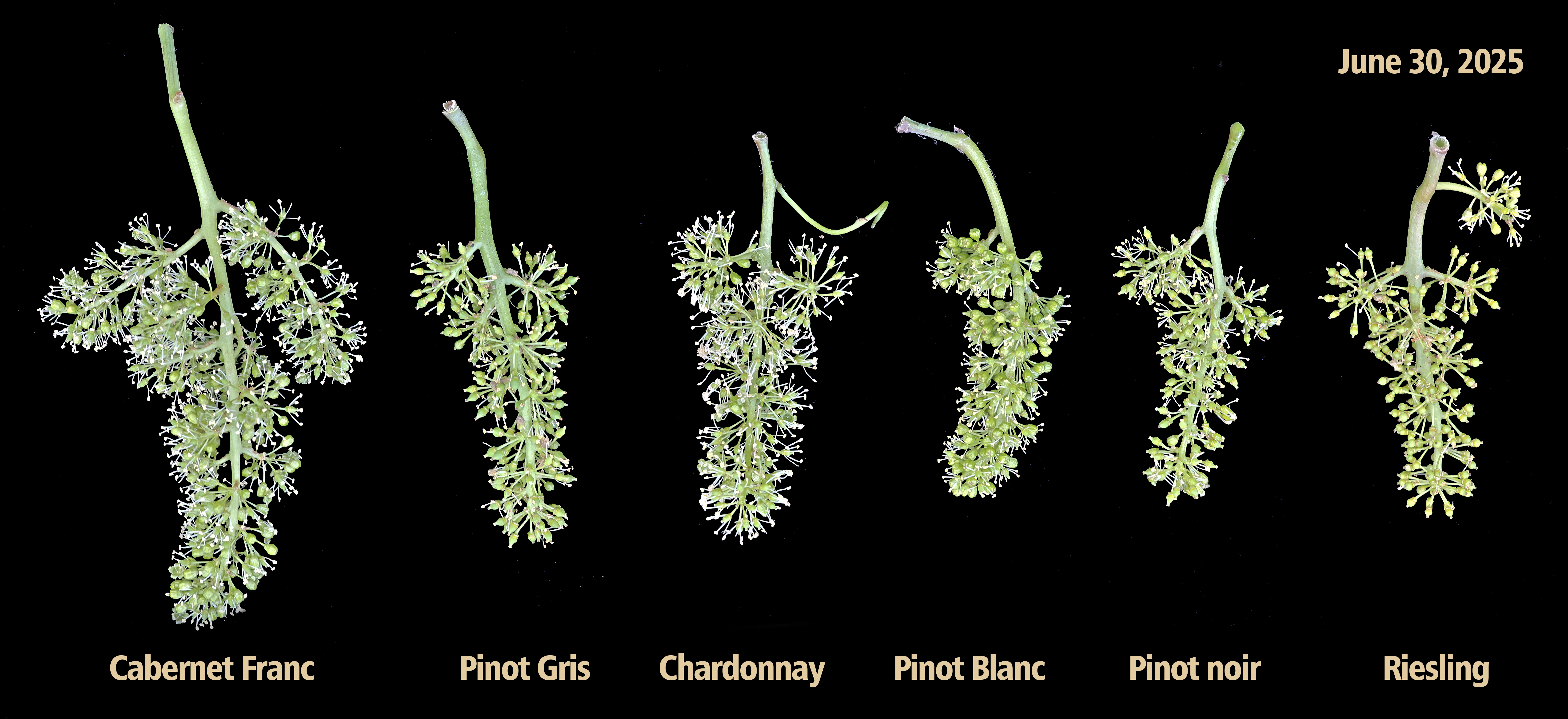
In the Tip of the Mitt American Viticulture Area, hybrid cultivars are in full bloom to fruit set stage. Vitis vinifera cultivars are in the first bloom stage of development. Rose chafers have been noted in some vineyards. Rainfall and high humidity has increased the risk for phomopsis, black rot and powdery mildew infection. Phomopsis and black rot pressure continue to increase.
In southeast Michigan, good fruit set is occurring around the region, with many varieties at pea size and some approaching berry touch. Grape berry moth counts at sites in Lenawee and Macomb counties dropped to 0. There is severe powdery mildew risk all week from July 2-9. There is negligible risk for downy mildew and black rot infections this week.
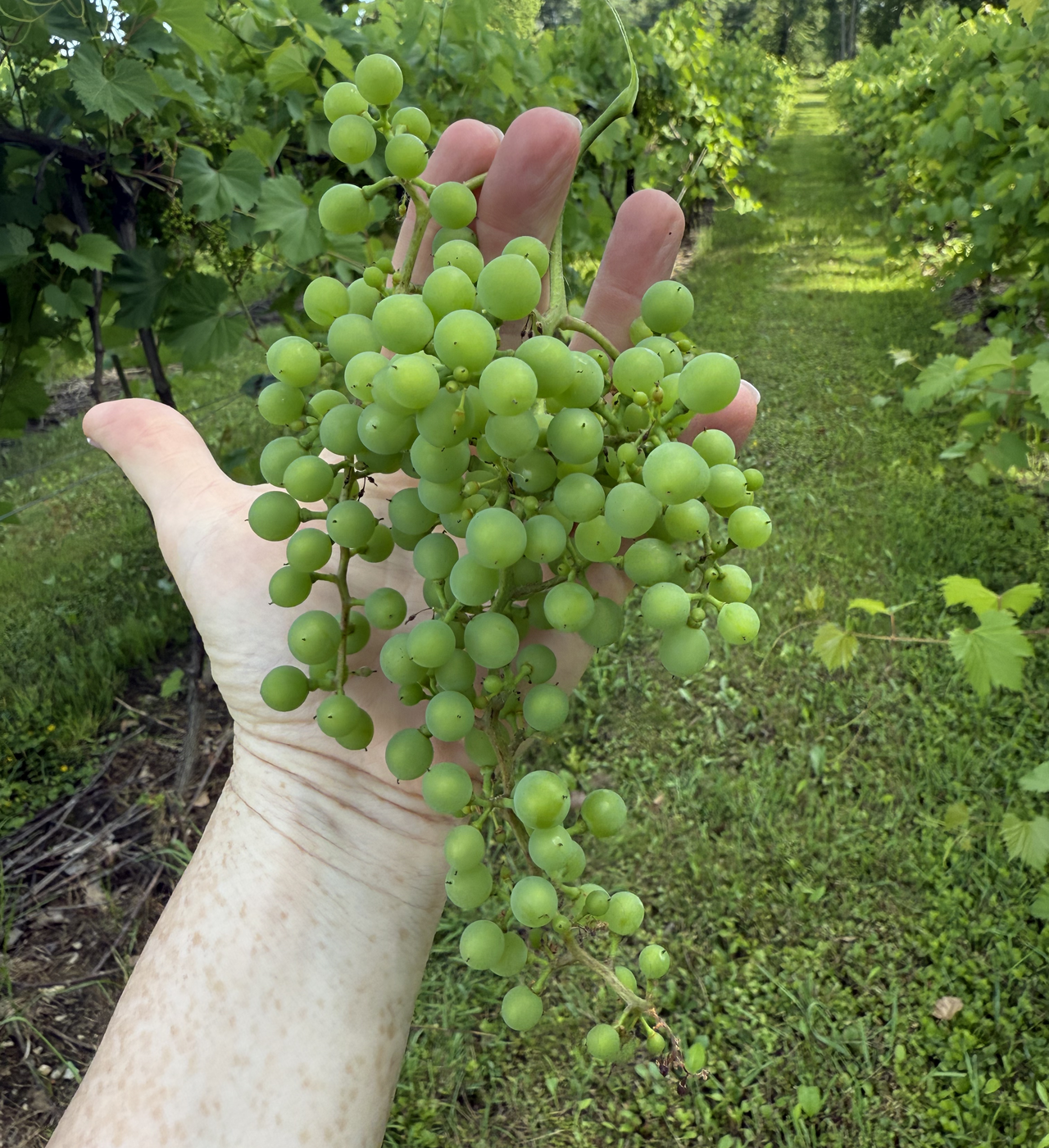
Horticulture
Accurate assessment of vineyard nutrient requirements is essential for optimizing vine health, fruit quality and yield. Implementing soil testing and petiole analysis provides critical data to inform nutrient management strategies. A quality soil test or a previous year’s petiole analysis is important in understanding which nutrients the vineyard needs.
Petiole analysis should be done at bloom and veraison, and at specific stages of vine development when nutrient concentrations in the petiole are most stable and representative of the vine's overall status. The most widely recommended timing for petiole sampling is at full bloom, which occurs when approximately 70% of the flowers on a cluster are open. This stage provides the most reliable data for key nutrients such as nitrogen, phosphorus, potassium and micronutrients.
An alternative or complementary sampling period is at veraison, when about half of the berries on a cluster begin to change color or soften. Sampling at veraison can be useful for monitoring nutrients like potassium, magnesium and boron later in the season or for tracking changes in nutrient dynamics over time.
The accuracy of petiole analysis depends heavily on sampling the correct leaf position. At full bloom, the petiole should be collected from the leaf that is directly opposite the basal grape cluster, typically the fourth to sixth leaf from the base of the shoot. This leaf is considered physiologically mature and reflective of the vine’s nutrient reserves at bloom. At veraison, petioles should be collected from recently matured leaves, generally located around the fifth to seventh leaf from the shoot tip.
A representative sample should include petioles from a sufficient number of vines across the block or variety, ideally 60 to 100 petioles collected from at least 20 to 25 randomly selected, healthy vines. Leaves chosen for sampling should be free of visible disease, pest damage or physical injury. To avoid contamination, petioles should be collected with clean tools and placed in a paper bag (not plastic) to allow for air drying. Samples should be clearly labeled with block, variety, date and phenological stage, and should be dried or delivered promptly to a testing laboratory.
When properly conducted, petiole analysis provides a clear snapshot of vine nutritional health and supports informed management decisions that contribute to balanced growth, fruit development and overall vineyard sustainability.
Soil tests evaluate nutrient content, pH levels and other soil characteristics, offering insights into the soil's fertility and potential nutrient deficiencies. Petiole analysis, which involves testing the leaf of grapevines, directly measures the nutrients absorbed by the plant, providing a more immediate understanding of the vine's nutritional status. Regular monitoring through these methods allows for timely adjustments to fertilization practices, ensuring optimal nutrient availability throughout the growing season.
During the early stages of vine growth, particular attention should be given to the application of nitrogen, zinc and boron, as these nutrients are vital for shoot development and flowering. Potassium and magnesium are also important during this period, supporting various physiological processes within the vine.
Nitrogen plays a crucial role in vegetative growth and fruit development. However, its application must be carefully managed:
- Excessive nitrogen: Can lead to delayed flowering and excessive vegetative growth, potentially compromising fruit set and quality.
- Insufficient nitrogen: May result in reduced vine vigor, leading to lower yields and diminished fruit quality.
Therefore, precise nitrogen management, informed by soil and petiole analyses, is essential to balance vegetative growth and fruit production effectively.
Often overlooked, trunk cleaning is critical for disease management and vine longevity. Trunks should be inspected and cleared of basal suckers and adventitious shoots that harbor pathogens and divert energy. Coupled with sucker removal, these sanitation practices create a cleaner, more efficient vine structure, which in turn eases future operations such as spraying and harvesting.
Cluster zone leaf removal: Timing and technique
To regulate grape quality in cool-climate regions, growers employ various canopy management practices to counter the challenges of a short growing season. One of the most impactful techniques is cluster zone leaf removal, which plays a key role in reducing disease pressure and enhancing fruit quality.
This practice improves spray coverage and airflow around the fruit, lowering humidity and minimizing the risk of harvest season cluster rot complex, including Botrytis and sour rot. Increased sunlight exposure also encourages development of a thicker wax cuticle on the berry skin, providing natural resistance to fungal infections and enhancing grape quality.
Leaf removal can be performed manually or mechanically, and the industry is rapidly transitioning toward mechanization to improve both efficiency and economic sustainability. The effectiveness of this practice depends heavily on timing, particularly in relation to grapevine phenology.
Leaf removal is typically applied between fruit set and veraison to improve cluster zone microclimate and increase disease resistance. When implemented around bloom or shortly before, it can also reduce fruit set and result in looser clusters, a valuable outcome for tight-clustered cultivars like Pinot noir and Riesling, which are prone to rot due to berry compression.
Early leaf removal, at pre-bloom or pea-size stage, offers additional benefits under climate change conditions:
- Promotes flavonol synthesis, protecting berries from UV damage.
- Reduces incidence of cluster rot, potentially lowering fungicide use.
Mechanical early leaf removal systems (Collard leaf remover) use compressed air to remove leaves and dead flower tissue from the fruit zone. Removing dead ovaries is critical, as they serve as an entry point and nutrient base for Botrytis spores. The pathogen can remain latent until berry sugar levels rise and acidity drops, after which rot symptoms develop rapidly in warm, humid conditions.
Read more in the MSU Extension article, “Cutting to the core: Michigan State research leads a canopy innovation in cool-climate viticulture.”
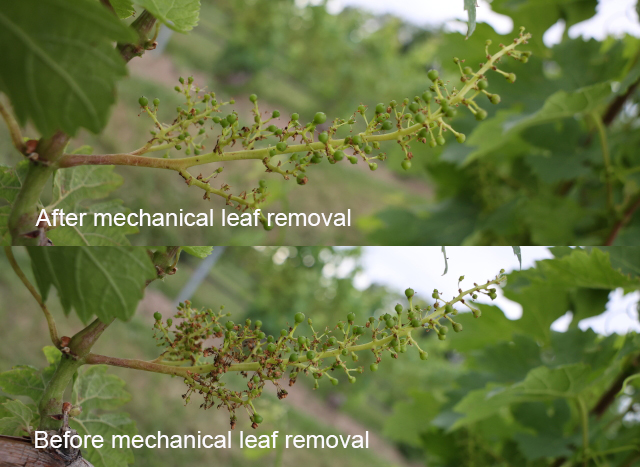
Diseases
During this time of the year, the primary diseases of concern for grape growers are phomopsis, black rot, anthracnose and powdery mildew. If you're seeking detailed insights into pre-bloom fungicide options and the effects of rain on disease spread, refer to previous grape scouting reports or exploring an article on early-season disease management. It's worth noting that some growers have recently observed isolated cases of downy mildew infections in northern vineyards. Southern vineyards have been seeing early infections of phomopsis and are beginning to see black rot lesions on developing fruit.
As bloom continues in southwest Michigan, start choosing fungicides that control all the fruit diseases (i.e., powdery mildew and botrytis bunch rot), such as chemicals in FRAC codes 7, 9, 11 and 12 . For example, with downy mildew we are most concerned with fruit infection at this time and sprays should be timed prior to bloom and at bloom for optimal control. Downy mildew is caused by a fungal-like organism, so many site-specific systemic fungicides that target other spring diseases do not work on downy mildew. Effective fungicides for downy mildew include products in FRAC codes 4, 11, 21, 40 and 45 as well as phosphorus acid salts and some biologically-based products.
With the exception of powdery mildew, these spring disease infections typically require rain events. It only takes 0.1 inches of rain above 50 F to trigger a possible infection. Viticultural practices that reduce canopy wetness such as good irrigation timing, leaf removal and good weed management can reduce many of these diseases in a vineyard. Typically, DMIs (FRAC 3), captan and EBDCs (FRAC M3) are effective for phomopsis, black rot and anthracnose.
Insects
We continue to see evidence of grape berry moth larvae feeding in clusters at scouting sites in SW Michigan. Some of these are evident from berries being bored into by the larvae, others have webbing around the feeding sites (see Photo 9) and some have both. These detections have mostly been along wooded borders, and are easy to detect by checking clusters at this time of year.
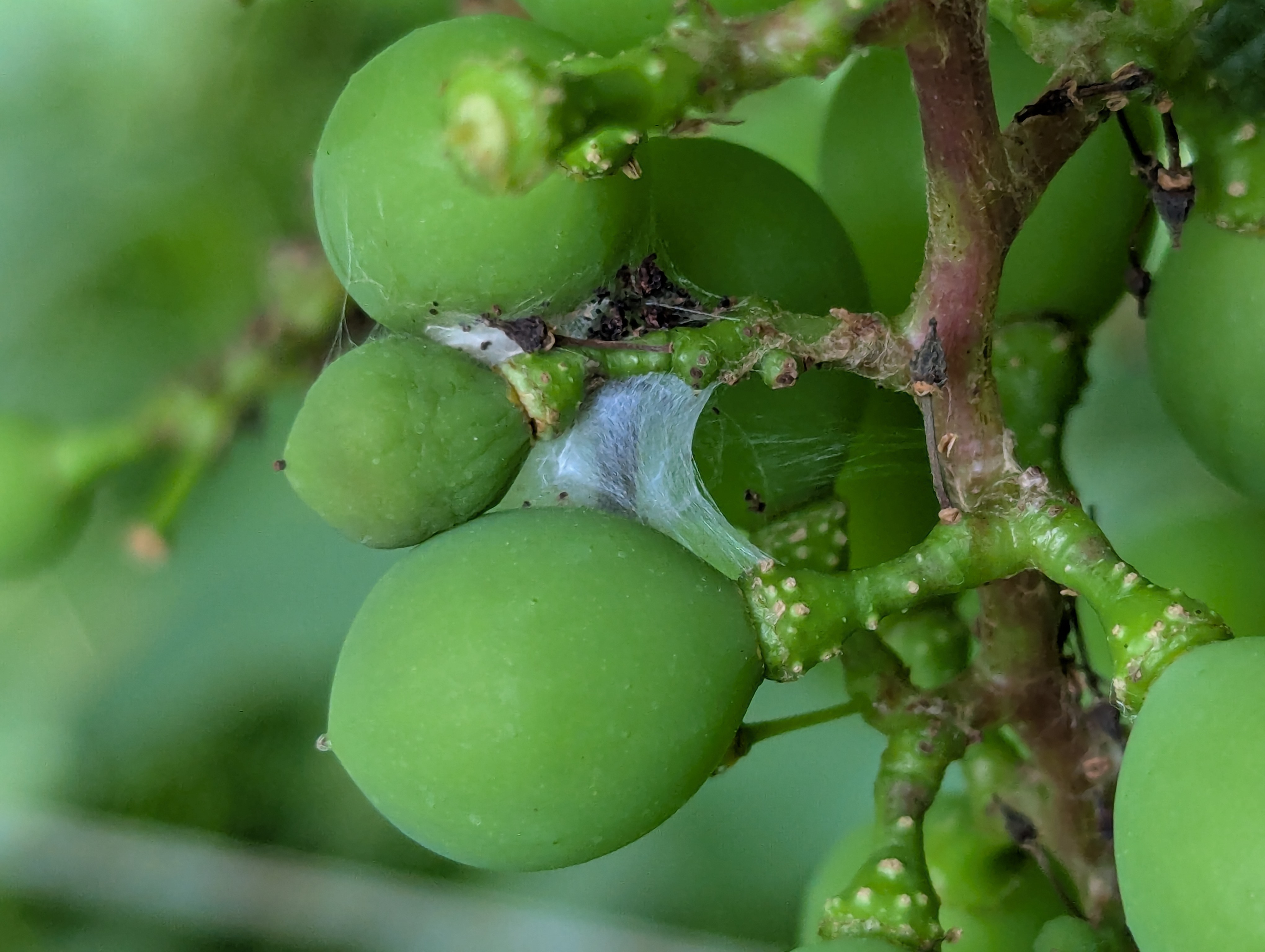
Treatment for berry moth at this time of the season can overlap with populations of leafhoppers, rose chafers and tumid gallmakers, so a thorough check of the vines is useful in early July to confirm they have low levels of any insect pests. Check the MSU Fruit Pest Management Guide (bulletin E154) for recommendations. A hard copy or a PDF version can be ordered from shop.msu.edu.
Now that we are further into the 2025 season, the dates for biofix of wild grape bloom in late May and early June can be used to predict timing of when the second generation starts egglaying using the grape berry moth Enviroweather model. The table below reports what you can see in the Enviroweather model based on the biofix dates listed. Use local values from your own farm. Insecticides targeting eggs such as Intrepid could be applied starting later this week in the far southwest of Michigan. Next week would be a good timing for broad spectrum products targeting egg hatch.
|
Location |
Wild grape bloom biofix |
Predicted start of Gen 2 egglaying (810 GDD) |
Predicted start |
|---|---|---|---|
|
Berrien Springs (Berrien Co.) |
June 2 |
July 3 |
July 6 |
|
Lawton (Van Buren Co.) |
June 3 |
July 4 |
July 7 |
|
Fennville (Allegan) |
June 4 |
July 5 |
Later than July 8 |
|
Deerfield (Lenawee) |
May 28 |
July 1 |
July 5 |
|
Romeo (Macomb Co.) |
May 30 |
July 4 |
Later than July 8 |
|
NW Station (Leelanau) |
June 10 |
Later than July 8 |
Later than July 8 |
We have received reports of grape cane girdler and grape cane gallmaker in recent weeks. The girdler cuts two rings of holes in the developing shoots (see Photo 10 ) whereas the gallmaker lays eggs in the cane, which then swells. Both pests are small beetles that are usually not noticed until the damage is done and the symptoms are seen when shoots start breaking off. They both have one generation per year and tend to be most abundant along wooded borders, so this can be an area for focused management to break the life cycle and stop the insects from developing.
When the damage is observed, cut off the shoot just below the damage and destroy the material to prevent the beetle’s development. In extreme cases, an immediate post-bloom insecticide application can help reduce populations.
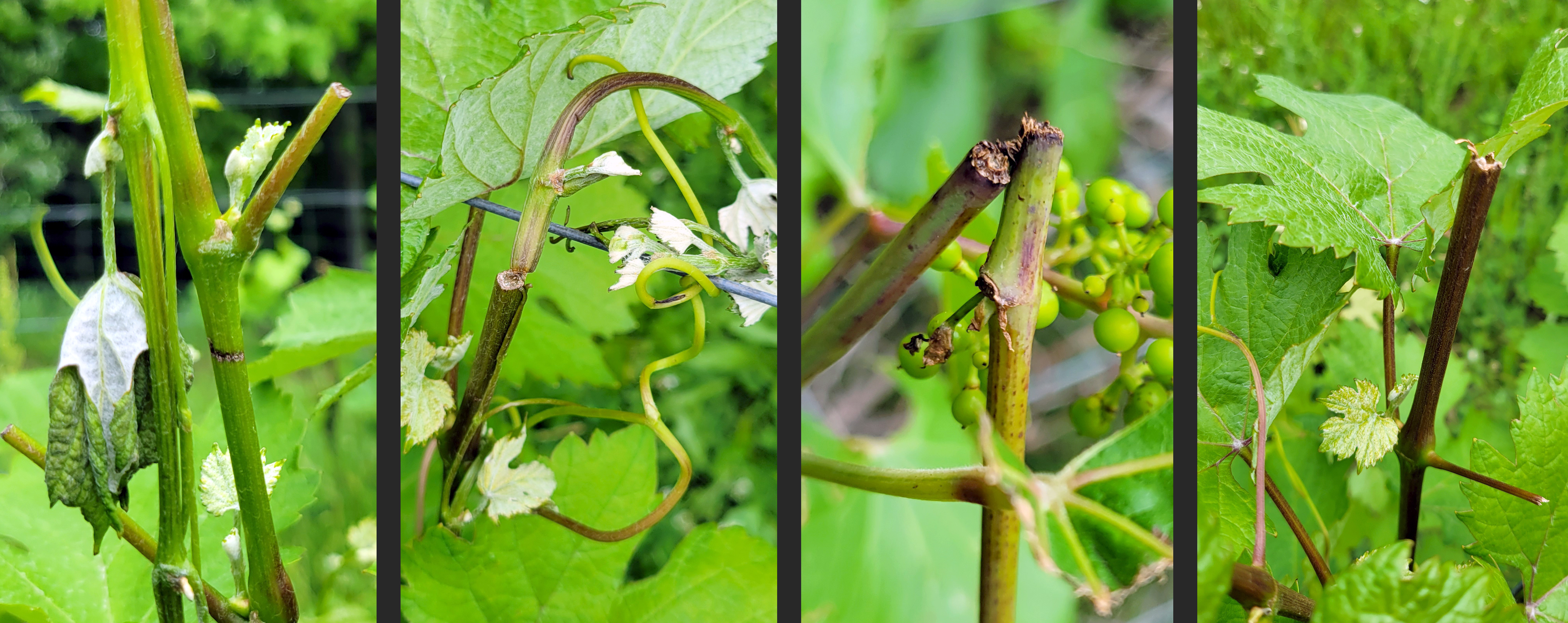
Make collaboration seamless with SAM Tool
The Sustainable Agricultural Management (SAM) Tool makes it easy for vineyard managers, field workers and research collaborators to stay organized, whether you’re in the office or out in the field. Using the SAM Tool from your phone or desktop, you can:
- View scouting photos and notes
- Assign and complete tasks
- Add task-completion comments
- Track restricted-entry areas
- Access the farm calendar
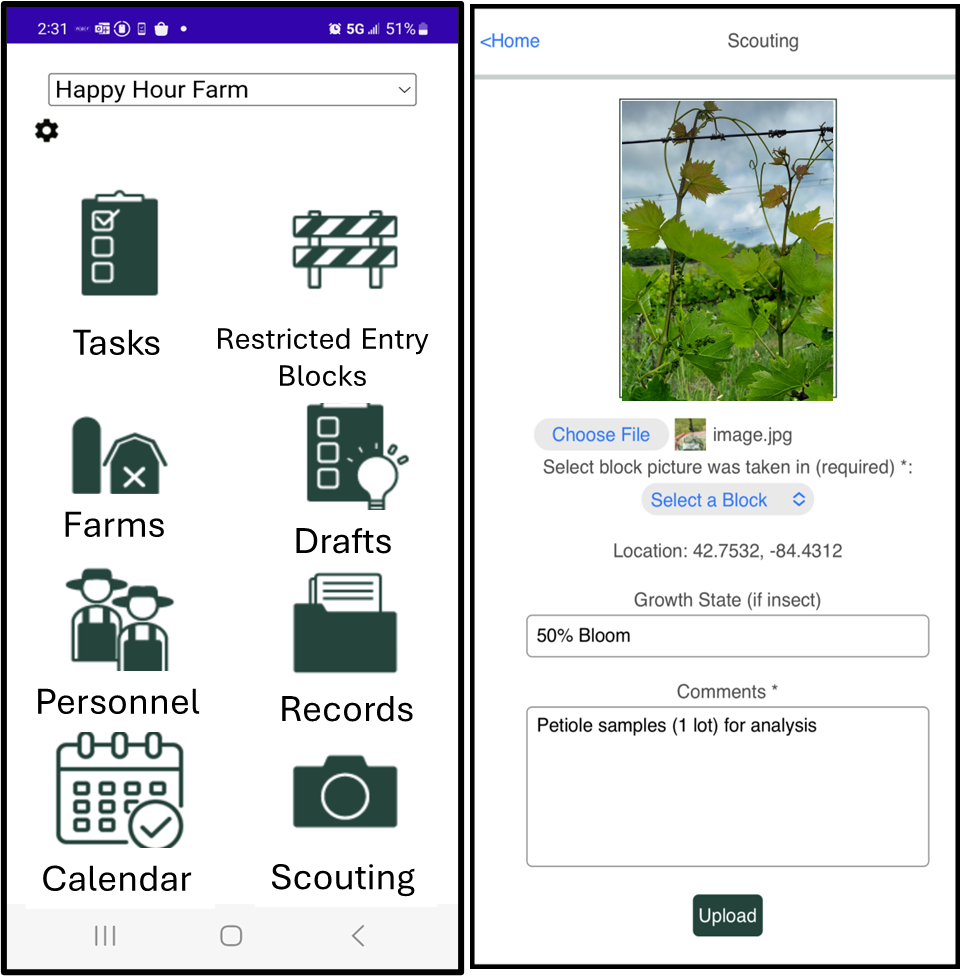
Get started with the mobile app
To add workers or collaborators to your digital farm team, they’ll need to create a free SAM Tool account on the SAM Tool website or directly in the mobile app:
- Android phones: SAM Tool on Google Play
- iPhones: SAM Tool on the App Store
Once workers or collaborators have signed up, farm managers can add them to the digital workforce using the “Add User” feature on the SAM Tool website. If you have suggestions or would like help getting started, please contact us at sustainableag@msu.edu or reach out to Karen Chou, PhD, directly at chouk@msu.edu. We’d be happy to show you how SAM Tool can support your vineyard’s recordkeeping, compliance and research efforts.
Let’s put Michigan wine on the map!
Michigan winemakers are invited to contribute wines for the upcoming American Society for Enology and Viticulture – Eastern Section annual meeting, taking place July 8-10, 2025. This national event offers a valuable platform to highlight the quality, diversity and innovation of Michigan’s wine industry to a broad audience of researchers, educators and industry professionals.
Wines of all styles are welcome. If direct shipping is not feasible, Esmaeil Nasrollahiazar from MSU Extension has offered to personally transport donated wines to the conference.
The final day to contribute is Thursday, July 3.
For more information or to arrange a donation, please contact Sarah Lowder at sarah.lowder@uga.edu or 704-574-4285, or Esmaeil Nasrollahiazar at nasroll2@msu.edu or 231-922-4621

Upcoming events
American Society for Enology and Viticulture – Eastern Section annual meeting
The American Society for Enology and Viticulture–Eastern Section annual meeting, held July 8-10, 2025 in Athens, Georgia, is a key gathering for grape and wine professionals across the region. This year’s conference will feature presentations on viticulture innovations, enology research, and climate adaptation strategies.
Highlights include:
- Invited speaker sessions
- Regional wine tasting featuring Michigan wines
- Networking with researchers, growers, and industry leaders
Pre-conference vineyard tours will take place July 8, followed by two days of technical sessions and tasting events.
If you’re planning to attend or contribute Michigan wines for the tasting, be sure to register soon. This is a great opportunity to stay connected with the broader grape and wine community and highlight Michigan’s contributions.
Third Thursday – Gibberellic Acid Vineyard Trial
Join us for an on-site vineyard presentation and tour focused on the ProGibb trial. We’ll explore the use of Gibberellic Acid in Pinot Blanc and Riesling, testing its efficacy alone and with two surfactants (Embrece-EA and Talavera) to reduce cluster compaction and mitigate Botrytis risk.
Date: Thursday, July 17, 2025
Time: 3:00 PM – 5:30 PM
Location: Hawthorne Vineyards, 1000 Camino Maria Dr, Traverse City, MI
The 36th annual Michigan Viticulture Field Day and 2nd annual Michigan Enology Experience
Michigan State University’s famous Viticulture Field Day on July 30 is a staple for the state’s grape growing community. The latest local viticulture research will be showcased. New last year for the winemakers, MSU partnered with Lake Michigan College to add a second day for wine making education. The Michigan Enology Experience on July 31 provides hands-on education for new and established enologists alike. View more information and registration details.
2025 Dirt to Glass Conference: Elevating Michigan Wine from the Ground Up
Join grape growers, winemakers, researchers and industry leaders Aug. 21-22 in Traverse City, Michigan, for two days of insight, collaboration and innovation. From site selection to sustainable practices and wine marketing, this event is designed to strengthen Michigan’s wine industry—one vine and one voice at a time. Register now and be part of the movement from intention to impact.
Follow us on Facebook and Instagram for the latest industry news, educational programs and viticulture resources. Stay connected and informed with timely updates and expert insights.
Related articles
- Rose chafer management for northwest vineyards
- Fruit insecticide registration update for 2023
- Southwest Michigan fruit update – June 4, 2024
- Michigan grape scouting report – June 8, 2022
- MSU Fruit Pest Management Guide (E-154)
- Grape growth stages
- Early season vineyard disease management
- Early season vineyard management
- A Mobile Guide for Grape IPM Scouting in North Central and Eastern U.S.
- Using the MSU Enviroweather grape berry moth model in 2018



 Print
Print Email
Email
